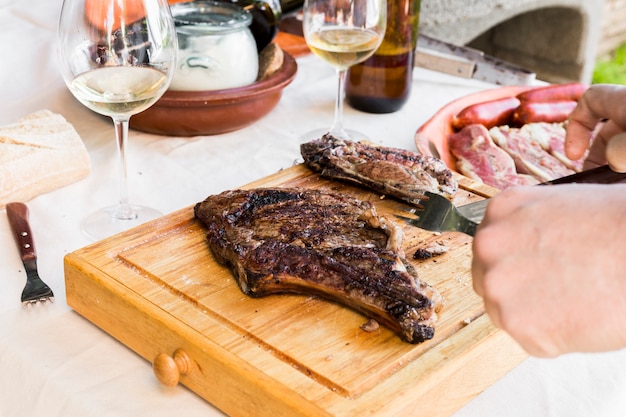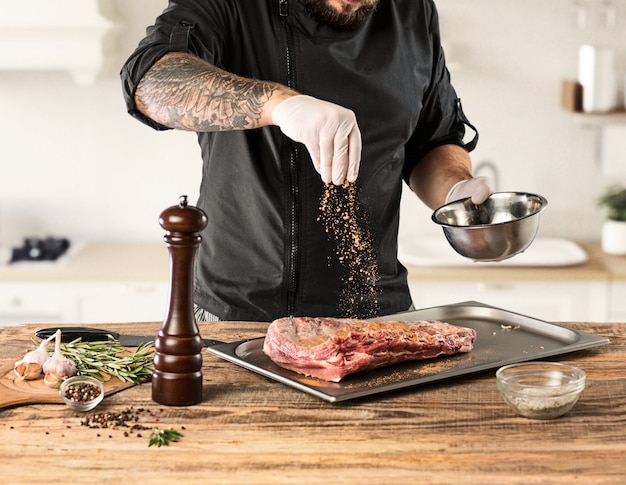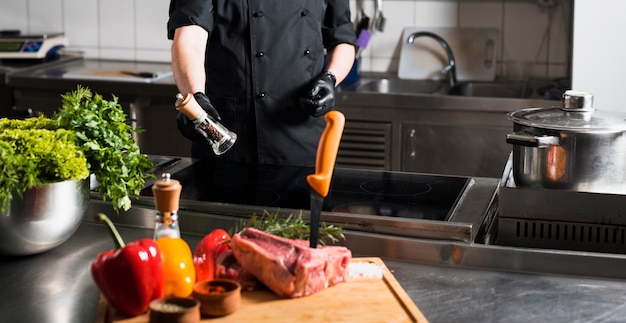(Part 1) choosing the right cut: Your Steak's Foundation

The Classics: Dependable and Delicious
Rib-eye: This is the undisputed king of steaks, and for good reason. It's known for its rich, buttery flavor and generous marbling, which translates to incredible juiciness. It's also a forgiving cut, making it perfect for both seasoned cooks and those just starting out. Sirloin: A worthy contender for the throne, sirloin is a leaner option than rib-eye, but it still packs a punch in terms of flavor. It's a fantastic choice if you're looking for a more budget-friendly cut without sacrificing quality. Fillet (Tenderloin): This is the epitome of tenderness, literally melting in your mouth. It's also the most expensive cut, reflecting its luxurious texture. Be mindful that its delicate flavor can sometimes be overshadowed by overly heavy seasoning.Beyond the Basics: Expanding Your Steak Horizons
T-bone: This cut is a true showstopper, featuring a hefty bone that acts as a natural divider between the tender filet and the more flavorful strip steak. It offers a fantastic blend of tenderness and flavor, making it a real crowd-pleaser. new york strip: Think of this cut as a more marbled, juicier version of sirloin. It's known for its rich flavor and beautiful marbling, making it a fantastic choice for a special occasion.Thickness Matters: Getting the Right Dimensions
The thickness of your steak is just as important as the cut. You want a steak that's thick enough to cook evenly without drying out, but not so thick that it takes an eternity to reach the perfect doneness. Aim for a steak that's about 1-1.5 inches thick.(Part 2) Preparing for Perfection: Getting Your Steak Ready

Room Temperature is Key: Unlocking Even Cooking
One of the most important steps is bringing your steak to room temperature before cooking. Imagine a steak pulled straight from the refrigerator, cold and stiff. It's not going to cook evenly. By letting the steak sit out for about 30 minutes, it will reach a more consistent temperature, leading to a more evenly cooked and juicy steak.Seasoning Like a Master: Elevating Flavor
Seasoning your steak isn't just about adding salt and pepper. It's an art form that can transform your steak from ordinary to extraordinary. Here's a peek into my seasoning arsenal: Garlic: The undisputed king of steak seasonings, garlic adds a beautiful aroma and depth of flavor that complements beef perfectly. Rosemary: A touch of rosemary adds a lovely herbal note that beautifully balances the richness of the steak. Paprika: A sprinkle of paprika introduces a subtle smokiness that adds complexity to the flavor profile. Cumin: This warm, earthy spice pairs wonderfully with beef, adding a unique depth of flavor. Salt and Pepper: Don't underestimate the power of classic seasonings. Salt enhances the steak's natural flavors, while pepper adds a touch of heat.Remember, these are just starting points. Feel free to experiment with your favorite herbs and spices, creating unique flavor combinations that you'll come back to time and time again.
(Part 3) Mastering the Heat: cooking techniques for steak perfection

The Pan Method: Sizzling Simplicity
The pan method is a great choice for beginners. It's relatively straightforward and requires minimal equipment. Here's the breakdown:1. Get your pan blazing hot: I'm talking scorching hot! Grab a heavy-bottomed pan, preferably cast iron, and place it over medium-high heat. You want the pan to be so hot that it sizzles when you drop a few drops of water on it. 2. Sear the steak: This is where the magic happens. Place your steak in the hot pan and let it cook undisturbed for 2-3 minutes per side. This intense heat creates a beautiful, caramelized crust, locking in the juices and enhancing the flavor. Resist the urge to move the steak around during this stage; let the crust form undisturbed.3. Reduce the heat: After searing, lower the heat to medium and continue cooking the steak for another 2-3 minutes per side, or until it reaches your desired doneness. This slower cooking phase allows the steak to cook evenly throughout.The Grill Method: Embracing the Outdoor Flavor
The grill method offers a unique smoky flavor that can't be replicated indoors. Here's how to grill a perfect steak:1. Heat the grill: Fire up your grill and bring it to high heat, around 450-500 degrees Fahrenheit. Let the grates heat up thoroughly before placing the steak.2. Sear the steak: Place the steak on the hot grill and let it cook for about 2-3 minutes per side, or until it develops a nice brown crust. 3. Reduce the heat: Lower the heat to medium and continue cooking the steak for another 2-3 minutes per side, or until it reaches your desired doneness.(Part 4) Doneness Demystified: Knowing When Your Steak is Perfect
There's a whole language when it comes to steak doneness, words like "rare," "medium-rare," and "well-done" that can be a bit confusing for the uninitiated. Let's break it down:The steak doneness chart: Your Guide to Perfection
| Doneness | internal temperature (Fahrenheit) | Internal Temperature (Celsius) | Description ||---|---|---|---|| Rare | 125-130 | 52-54 | Cool red center, warm outer edge || Medium-Rare | 130-135 | 54-57 | Warm pink center, hot outer edge || Medium | 135-140 | 57-60 | Pink center, slightly brown edges || Medium-Well | 140-145 | 60-63 | Slight pink center, brown edges || Well-Done | 145 | 63 | Brown all the way through, no pink |The Touch Test: A Hands-On Approach
If you don't have a meat thermometer, you can use the touch test to estimate doneness. Here's how: Rare: Steak will feel very soft, almost like jello. Medium-Rare: Steak will feel slightly firm, but still yielding to the touch. Medium: Steak will feel firm and springy. Medium-Well: Steak will feel very firm, with little give. Well-Done: Steak will feel hard and rigid.(Part 5) Resting is Essential: Letting Your Steak RecoupYou've just cooked a beautiful, crusty steak, but hold on! Don't slice into it just yet. Instead, let it rest for 5-10 minutes before slicing. This allows the juices, which have been pushed to the surface during cooking, to redistribute throughout the steak, resulting in a more tender and juicy cut.Sauce Symphony: Adding the Final Touch
While your steak is resting, take this opportunity to prepare your sauce. A well-crafted sauce can elevate your steak to a whole new level of deliciousness. Here are a few classic options: Béarnaise Sauce: This rich, creamy, and slightly tangy sauce is a classic pairing for steak. It's made with egg yolks, butter, and tarragon, creating a flavor that's both sophisticated and satisfying. Peppercorn Sauce: This spicy and peppery sauce adds a bold kick to your steak. It's perfect for those who enjoy a bit of heat. Red Wine Sauce: A rich and flavorful sauce that incorporates red wine, shallots, and herbs, creating a complex and satisfying flavor.(Part 6) Serving Your steak masterpiece: A Feast for the Eyes
Now that your steak is rested and your sauce is ready, it's time to present your culinary creation in all its glory. Slicing with Precision: Cut the steak across the grain, about ?? inch thick. This will make the steak more tender and easier to chew. Presentation Matters: Arrange your steak beautifully on a plate. You can create a visually appealing display by adding simple side dishes, such as roasted vegetables, mashed potatoes, or a green salad.(Part 7) Side Dish Showdown: Perfecting the Supporting Cast
Your steak is the star of the show, but its supporting cast, the side dishes, plays a crucial role in creating a balanced and harmonious culinary experience. Here are some classic side dishes that perfectly complement a steak:Starches: The Foundations of a Hearty Meal
Mashed Potatoes: A classic, comforting side dish that pairs beautifully with the richness of steak. Roasted Potatoes: Crisp on the outside and fluffy on the inside, these potatoes offer a satisfying texture contrast to the tender steak. Fries: From classic french fries to wedges and sweet potato fries, there's a fry style for every taste.Vegetables: Adding Bright Flavors and Textures
Asparagus: Perfectly roasted asparagus adds a touch of freshness and lightness to the meal. green beans: Sautéed green beans with garlic and olive oil are a simple and satisfying side dish that complements the steak without overpowering it. roasted brussels sprouts: Brussels sprouts, when roasted properly, can be a surprisingly delicious and satisfying side dish, offering a unique flavor and texture.Salads: Bringing a Touch of Freshness
Caesar Salad: This classic salad with its creamy dressing and crunchy croutons adds a refreshing counterpoint to the richness of the steak. Mixed Greens Salad: A simple mixed greens salad with a vinaigrette dressing offers a light and refreshing option that won't weigh you down.(Part 8) Tips and Tricks: Fine-Tuning Your Steak Game
Now that you've got the basics down, let's delve into some tips and tricks that will elevate your steak cooking to the next level: Invest in a Meat Thermometer: A meat thermometer is the most accurate way to ensure your steak is cooked to your desired doneness. It takes the guesswork out of cooking and ensures you consistently achieve perfect results. Don't Overcook it: Overcooked steak is dry and tough, so it's crucial to cook it to the correct doneness. Use a meat thermometer to avoid overcooking and maintain the steak's juicy tenderness. Rest, Rest, Rest: Resting the steak is essential for allowing the juices to redistribute throughout the meat. This results in a much juicier and more tender final product. Experiment with Seasonings: Don't be afraid to get creative with your seasonings. Experiment with different herbs and spices to find unique flavor combinations that you'll love.(Part 9) FAQs: Answers to Your Steak Queries
You've got the knowledge, you've got the skills, but if you still have questions, don't hesitate to ask! Here are some frequently asked questions to get you started:1. What if I don't have a meat thermometer?
If you don't have a meat thermometer, you can use the touch test to estimate the doneness. Press on the steak; it will feel soft for rare, slightly firm for medium-rare, firm for medium, very firm for medium-well, and hard for well-done. However, this method is less precise than using a meat thermometer.2. What's the best way to store steak?
Store steak in the refrigerator, wrapped tightly in plastic wrap or aluminum foil. This will help prevent the steak from drying out. 3. How long can I store steak in the refrigerator?
You can store steak in the refrigerator for up to 5 days.4. Can I freeze steak?
Yes, you can freeze steak. Wrap it tightly in plastic wrap or aluminum foil before freezing to prevent freezer burn. Frozen steak can be stored for up to 3 months.5. What's the best way to thaw frozen steak?
The best way to thaw frozen steak is to place it in the refrigerator overnight. This allows the steak to thaw slowly and evenly. You can also thaw it in cold water, but avoid thawing it at room temperature as this can lead to bacterial growth.
Congratulations! You're now armed with the knowledge and skills to cook a steak that will impress even the most discerning palate. Go forth, master the art of steak cooking, and create culinary masterpieces that will make you the envy of all your friends and family. Happy grilling!
Everyone is watching

Prime Rib Roast Cooking Time Chart: Per Pound Guide
Cooking TipsPrime rib roast. Just the name conjures images of lavish dinners, crackling fires, and hearty laughter. It’s ...

How Long to Bake Potatoes in the Oven (Perfect Every Time)
Cooking TipsBaked potatoes are a staple in my kitchen. They're incredibly versatile, delicious, and surprisingly easy to m...

Perfect Rice Every Time: The Ultimate Guide to Cooking Rice
Cooking TipsAs a self-proclaimed foodie, I've always been a bit obsessed with rice. It's the foundation of countless cuisi...

The Ultimate Guide to Cooking Asparagus: Tips, Techniques, and Recipes
Cooking TipsAsparagus. The mere mention of this spring delicacy conjures up images of vibrant green spears, crisp and burs...

Ultimate Guide to Cooking the Perfect Thanksgiving Turkey
Cooking TipsThanksgiving. Just the word conjures up images of overflowing tables laden with delicious food, the scent of r...
